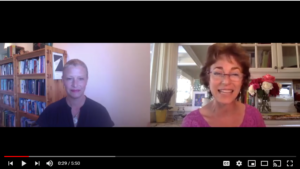
Jae Gruenke, via Facebook
by Jae Gruenke, GCFP
2019 FGNA Conference Presenter
I wasn’t always a runner. In fact, when I first started running as an adult, it felt astonishingly awful.
At the time, I was a professional modern dancer. One particular gig I got involved performing in parks, basketball courts, and other large, outdoor spaces. It required a lot of running, and I wasn’t used to that. When I started running to train for the performances, I found it a miserable experience…and that seemed fishy to me.
Although as a dancer, I was capable of movement in ways “regular people” can’t dream of, I couldn’t comfortably do this basic human gait that everyone’s supposed to be able to do! I suspected there must be something wrong with how I was running. Since I was enrolled in a Feldenkrais® professional training program at the time, I decided to use it as a laboratory to figure out what the difference was between 1) how I was running, and 2) how people who looked comfortable and skilled ran. After each Feldenkrais lesson, I would go for a run to see how I felt.
As a result, I had several amazing breakthroughs, and after graduation I found I liked running better than dancing. I retired from dance and decided to focus my practice on working with runners.
I made many discoveries that were never discussed in Runner’s World or by other coaches. I realized it was important for me to share my insights for successful and sustainable running. In the 16 years since I became a Guild Certified Feldenkrais PractitionerCM, I’ve helped countless runners, from beginner to Olympian, feel better and run faster.
Early on, I realized the importance of the spring system. As many runners know, running is basically a series of jumps, with each landing storing energy in your body as in a compressed spring. Then that energy helps produce your next toe-off so you can have the moment in the air that defines running.
We’re told it’s the arches of the feet and the bending of the legs that are responsible for this spring action. But as a Feldenkrais® practitioner, I realized that it’s actually the whole body that acts as a spring, with the pelvis, spine, and even the head contributing. When you learn how to let that happen, you run much more easily and have fewer injuries. I’m excited to be teaching a workshop on how to do this at the annual conference this year.
Runners are usually coached to avoid landing on their heels, and to strive for a midfoot or forefoot footstrike instead. Straining to accomplish this has injured many runners and created a lot of frustration. However, runners who participate in my conference workshop will find that their footstrike spontaneously optimizes to a midfoot strike near their center of gravity. That’s a delightful bonus of learning to use your springs.
Through Feldenkrais lessons, my students are surprised that their running form and coordination improve so that running feels comfortable and natural. Traditional coaching methods of cues, drills, and even physical therapy exercises often result in frustration and a sense of awkwardness. If your running starts to feel like that when you’re trying to improve it, you’re on the wrong track! Good running feels like it did when you were a kid—spontaneous, physical, free, and fun.
Learn more about Jae Gruenke at www.balancedrunner.com and on YouTube
Eager to get started? Try Jae’s free 1-week “Mind Your Running” Challenge.
Ready to register or learn more? Details here.


